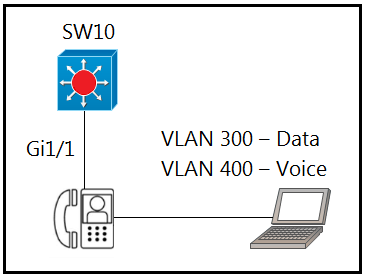
Refer to the exhibit. An engineer must configure GigabitEthernet1/1 to accommodate voice and data traffic. Which configuration accomplishes this task?

Refer to the exhibit. An engineer must configure GigabitEthernet1/1 to accommodate voice and data traffic. Which configuration accomplishes this task?
To configure GigabitEthernet1/1 to accommodate both voice and data traffic, the switchport should be set to access mode with separate VLANs for voice and data. This ensures that data traffic uses VLAN 300 and voice traffic uses VLAN 400. The configuration commands should enable the port to handle both types of traffic effectively. Therefore, the correct configuration is to set the switchport to access mode, assign VLAN 300 for data, and specify VLAN 400 for voice using the 'switchport voice vlan' command.
A is correct
PAGE198, VOL1; Example 8-8 Configuring the Voice and Data VLAN on Ports Connected to Phones
How can this be correct? Access ports can only process one vlan per port.
VoIP phones work in a weird way. The access port is split into two ports, one for voice and one for data. So somehow the access access port behaves like a trunk.
Correct
A is correct trunk has nothing to do in this question
The correct answer is A because there is nothing about trunks in the question being asked. gg good day Go Dodgers
https://study-ccna.com/configuring-voice-vlans/
Voice VLANs work like this.
Guys, how can a access port manage to process two different Vlans over the same interface, not convinced with the ans.
It is a trunk but not configured as a trunk. Voice VLANS are weird. https://networklessons.com/cisco/ccna-routing-switching-icnd1-100-105/voice-vlan
While A seems to be incorrect syntax and an invalid command line, of the choices listed A is the best answer. https://www.learncisco.net/courses/icomm-ccna-voice/cisco-uc-solution-maintenance/switch-configuration.html#:~:text=Cisco%20allows%20us%20to%20have%20two%20VLANs%20connected%20to%20one%20port%2C%20it%27s%20a%20multi-VLAN%20access%20port.%20And%20Cisco%20allows%20us%20to%20bend%20the%20rules%20if%20and%20only%20if%20one%20of%20those%20two%20VLANs%20is%20a%20voice%20VLAN https://community.cisco.com/t5/switching/subinterface-to-access-port/td-p/3804800 https://www.reddit.com/r/networking/comments/m5ruhr/8021x_and_allowing_phones_on_voice_vlan/ https://www.cisco.com/c/en/us/support/docs/switches/catalyst-2950-series-switches/113260-voice-vlan-00.html#:~:text=Configure%20specified%20VLANs%20for%20voice%20and%20data%20traffic https://www.cisco.com/c/en/us/td/docs/switches/lan/catalyst2960/software/release/12-2_40_se/configuration/guide/scg/swvoip.pdf
There are a couple of extra step you have to do to make answer D work and it's not given in the choices so I stayed away from it. i.e. on G1/1 sw tr en dot sw mod tr sw tr al nat vl { 0-4094} sw voice vl 400
Some very good discussions covering answer D which illustrate this command line being invalid: https://community.cisco.com/t5/switching/what-happens-when-voice-vlan-command-is-added-to-a-trunk-port/td-p/1570579 https://learningnetwork.cisco.com/s/question/0D53i00000Kt1GR/voice-vlan-on-a-trunk-port
A is correct VoIP concept
A is correct
A indeed
D: You need to enable protected management frame under the SSID configured
For some this may be confusing and it go be the first time around untill i looked at the answer more clearly. The answer is A, because lets say you wanted to configure the port as a management port, you would want to configure that interface first before the voice vlan. Thats the only I remember from working with switching as an administrator
https://www.cisco.com/c/en/us/td/docs/switches/lan/catalyst2960/software/release/12-2_40_se/configuration/guide/scg/swvoip.pdf